The Psychophysiological Interrelationship Between Working Conditions and Stress of Harvester and Forwarder Drivers—A Study Protocol
Abstract
1. Introduction
1.1. Study Aims
1.2. A Multimodal Approach
2. Background and Operational Context
2.1. Harvester and Forwarder Machines
2.2. Self-Reported Psychological States
2.3. Factors Influencing Psychological and Technical Parameters
2.4. Assessment of Psychophysiological Parameters
2.4.1. Heart Rate Variability (HRV)
2.4.2. Eye Tracking
2.4.3. Cortisol
2.4.4. Arousal and Electrodermal Activity
2.4.5. Arousal and Facial Expression Analysis (FEA)
2.5. Possible Effects of Stressful Situations
3. Participants and Study Sites
4. Materials and Equipment
4.1. Forest Environment
4.2. Machine-Related Parameters and Technical Outcomes
4.3. Psychological Parameters
4.3.1. Sleep, Arousal and Mental Strain
4.3.2. Quality of Life, Mental Stress, and Recovery
4.3.3. Interview
4.4. Psychophysiological Parameters
4.4.1. Heart Rate Variability
4.4.2. Eye Fixation Duration
4.4.3. Cortisol Level
4.4.4. Electrodermal Activity
4.4.5. Facial Expressions
5. Detailed Procedure
5.1. Measurement Schedule and Outcomes
5.2. Data Processing
6. Discussion and Conclusions
Supplementary Materials
Author Contributions
Funding
Institutional Review Board Statement
Informed Consent Statement
Data Availability Statement
Acknowledgments
Conflicts of Interest
References
- Lackner, C.; Schreck, M.; Walli, A.-M. Austrian Forest Report 2023; Federal Ministry of Agriculture, Forestry, Region, and Water Management: Vienna, Austria, 2023. [Google Scholar]
- Holzfeind, T.; Visser, R.; Chung, W.; Holzleitner, F.; Erber, G. Development and Benefits of Winch-Assist Harvesting. Curr. For. Rep. 2020, 6, 201–209. [Google Scholar] [CrossRef]
- Jodłowski, K.; Kalinowski, M. Current Possibilities of Mechanized Logging in Mountain Areas. For. Res. Pap. 2018, 79, 365–375. [Google Scholar] [CrossRef]
- Szewczyk, G.; Spinelli, R.; Magagnotti, N.; Tylek, P.; Sowa, J.; Rudy, P.; Gaj-Gielarowiec, D. The Mental Workload of Harvester Operators Working in Steep Terrain Conditions. Silva Fenn. 2020, 54, 10355. [Google Scholar] [CrossRef]
- Holzfeind, T.; Stampfer, K.; Holzleitner, F. Productivity, Setup Time and Costs of a Winch-Assisted Forwarder. J. For. Res. 2018, 23, 196–203. [Google Scholar] [CrossRef]
- Kühmaier, M.; Stampfer, K. Development of a Multi-Criteria Decision Support Tool for Energy Wood Supply Management. Croat. J. For. Eng. 2012, 33, 181–198. [Google Scholar]
- Cavalli, R.; Amishev, D. Steep Terrain Forest Operations—Challenges, Technology Development, Current Implementation, and Future Opportunities. Int. J. For. Eng. 2019, 30, 175–181. [Google Scholar] [CrossRef]
- Hittenbeck, J. Limitations of highly mechanized timber harvesting in slopes. AFZ-DerWald 2011, 66, 30–33. [Google Scholar]
- Visser, R.; Stampfer, K. Expanding Ground-Based Harvesting onto Steep Terrain: A Review. Croat. J. For. Eng. 2015, 36, 321–331. [Google Scholar]
- Garland, J.; Belart, F.; Crawford, R.; Chung, W.; Cushing, T.; Fitzgerald, S.; Green, P.; Kincl, L.; Leshchinsky, B.; Morrissette, B.; et al. Safety in Steep Slope Logging Operations. J. Agromed. 2019, 24, 138–145. [Google Scholar] [CrossRef] [PubMed]
- Nemestóthy, N. Erhebung der Holzerntekapazitäten und Waldpflegekapazitäten der in Österreich tätigen Forstbetriebe bzw. forstlichen Dienstleistungsunternehmer und Entwicklung Einer Datenbank als Informationssystem für Waldbewirtschafter 2022. Available online: https://www.forstholzpapier.at/images/BEILAGE_E_Top6_NEMESTOTHY_Abschlussbericht_Holzerntekapazit%C3%A4t_korr2022-07.pdf (accessed on 4 August 2025).
- Grollnigg, M.; Bauer, H. Holzeinschlagsmeldung 2022. Bundesministerium für Land- und Forstwirtschaft, Regionen und Wasserwirtschaft. 2023. Available online: https://www.bmluk.gv.at/dam/jcr:31024149-0f7a-45d8-bfb4-add65900c0cd/Brosch%C3%BCre%20HEM.pdf (accessed on 4 August 2025).
- ÖNORM EN ISO 10075-1:2017-01; Ergonomische Grundlagen Bezüglich Psychischer Arbeitsbelastung—Teil 1: Allgemeines Und Begriffe (Ergonomic Principles Related to Mental Workload—Part 1: General Terms and Definitions). Austrian Standards International: Vienna, Austria, 2018.
- Gaillard, A.W.K. Comparing the Concepts of Mental Load and Stress. Ergonomics 1993, 36, 991–1005. [Google Scholar] [CrossRef]
- Hacker, W.; Richter, P. Psychische Fehlbeanspruchung. Psychische Ermüdung, Monotonie, Sättigung und Streß; Zweite, veränderte und ergänzte Auflage; Springer: Berlin/Heidelberg, Germany, 1984; Volume 2, ISBN 978-3-642-87990-6. [Google Scholar]
- Matti, N.; Mauczok, C.; Specht, M.B. Müdigkeit, Fatigue und Erschöpfung: Alles das Gleiche oder Ausprägungen eines Kontinuums?—Ein Diskussionsanstoß. Somnologie 2022, 26, 187–198. [Google Scholar] [CrossRef]
- Das, K.V.; Jones-Harrell, C.; Fan, Y.; Ramaswami, A.; Orlove, B.; Botchwey, N. Understanding Subjective Well-Being: Perspectives from Psychology and Public Health. Public Health Rev. 2020, 41, 25. [Google Scholar] [CrossRef]
- Diener, E. The Science of Well-Being: The Collected Works of Ed Diener, 1st ed.; Springer Science & Business Media: Berlin/Heidelberg, Germany, 2009; Volume 37. [Google Scholar]
- Lee, D.H.; Kim, Y.J.; Choi, C.H.; Chung, S.O.; Nam, Y.S.; So, J.H. Evaluation of Operator Visibility in Three Different Cabins Type Far-East Combine Harvesters. Int. J. Agric. Biol. Eng. 2016, 9, 33–44. [Google Scholar]
- Naskrent, B.; Grzywiński, W.; Polowy, K.; Tomczak, A.; Jelonek, T. Eye-Tracking in Assessment of the Mental Workload of Harvester Operators. Int. J. Environ. Res. Public Health 2022, 19, 5241. [Google Scholar] [CrossRef]
- Cambi, M.; Certini, G.; Neri, F.; Marchi, E. The Impact of Heavy Traffic on Forest Soils: A Review. For. Ecol. Manag. 2015, 338, 124–138. [Google Scholar] [CrossRef]
- Cacioppo, J.T.; Tassinary, L.G.; Berntson, G.G. Psychophysiological Science. In Handbook of Psychophysiology; Cambridge University Press: Cambridge, UK, 2000; pp. 123–138. ISBN 62634X. [Google Scholar]
- Spinelli, R.; Magagnotti, N.; Labelle, E.R. The Effect of New Silvicultural Trends on the Mental Workload of Harvester Operators. Croat. J. For. Eng. 2020, 41, 175–190. [Google Scholar] [CrossRef]
- Singh, N.; Moneghetti, K.J.; Christle, J.W.; Hadley, D.; Plews, D.; Froelicher, V. Heart Rate Variability: An Old Metric with New Meaning in the Era of Using mHealth Technologies for Health and Exercise Training Guidance. Part One: Physiology and Methods. Arrhythmia Electrophysiol. Rev. 2018, 7, 193. [Google Scholar] [CrossRef]
- iMotions. Electrocardiography (ECG): The Complete Pocket Guide 2020; iMotions: Copenhagen, Denmark, 2020. [Google Scholar]
- iMotions. Eye Tracking: The Complete Pocket Guide 2017; iMotions: Copenhagen, Denmark, 2017. [Google Scholar]
- Galley, N.; Betz, D.; Biniossek, C. Fixation Durations—Why Are They so Highly Variable? In Das Ende von Rational Choice? Zur Leistungsfähigkeit der Rational-Choice-Theorie; SSOAR: Mannheim, Germany, 2015; Volume 3, pp. 1–26. [Google Scholar]
- De Rivecourt, M.; Kuperus, M.N.; Post, W.J.; Mulder, L.J.M. Cardiovascular and Eye Activity Measures as Indices for Momentary Changes in Mental Effort during Simulated Flight. Ergonomics 2008, 51, 1295–1319. [Google Scholar] [CrossRef]
- Liu, J.-C.; Li, K.-A.; Yeh, S.-L.; Chien, S.-Y. Assessing Perceptual Load and Cognitive Load by Fixation-Related Information of Eye Movements. Sensors 2022, 22, 1187. [Google Scholar] [CrossRef] [PubMed]
- Szewczyk, G.; Spinelli, R.; Magagnotti, N.; Mitka, B.; Tylek, P.; Kulak, D.; Adamski, K. Perception of the Harvester Operator’s Working Environment in Windthrow Stands. Forests 2021, 12, 168. [Google Scholar] [CrossRef]
- Kamgang, V.W.; Murkwe, M.; Wankeu-Nya, M. Biological Effects of Cortisol. In Cortisol—Between Physiology and Pathology; IntechOpen: London, UK, 2023. [Google Scholar]
- Veltman, J.A.; Gaillard, A.W.K. Indices of Mental Workload in a Complex Task Environment. Neuropsychobiology 1993, 28, 72–75. [Google Scholar] [CrossRef]
- Greff, M.J.E.; Levine, J.M.; Abuzgaia, A.M.; Elzagallaai, A.A.; Rieder, M.J.; van Uum, S.H.M. Hair Cortisol Analysis: An Update on Methodological Considerations and Clinical Applications. Clin. Biochem. 2019, 63, 1–9. [Google Scholar] [CrossRef]
- Van der Meij, L.; Gubbels, N.; Schaveling, J.; Almela, M.; van Vugt, M. Hair Cortisol and Work Stress: Importance of Workload and Stress Model (JDCS or ERI). Psychoneuroendocrinology 2018, 89, 78–85. [Google Scholar] [CrossRef]
- Mundy-Castle, A.C.; McKiever, B.L. The Psychophysiological Significance of the Galvanic Skin Response. J. Exp. Psychol. 1953, 46, 15–24. [Google Scholar] [CrossRef] [PubMed]
- Boucsein, W. Electrodermal Activity; Springer: Berlin/Heidelberg, Germany, 2012; pp. 1–3, 27, 31. ISBN 978-1-4614-1125-3. [Google Scholar]
- iMotions. Galvanic Skin Response: The Complete Pocket Guide 2017; iMotions: Copenhagen, Denmark, 2017. [Google Scholar]
- Affectiva Emotion AI 101: All About Emotion Detection and Affectiva’s Emotion Metrics. Available online: https://blog.affectiva.com/emotion-ai-101-all-about-emotion-detection-and-affectivas-emotion-metrics (accessed on 4 August 2025).
- iMotions. Facial Expression Analysis: The Complete Pocket Guide; iMotions: Copenhagen, Denmark, 2017. [Google Scholar]
- Bishay, M.; Preston, K.; Strafuss, M.; Page, G.; Turcot, J.; Mavadati, M. AFFDEX 2.0: A Real-Time Facial Expression Analysis Toolkit. arXiv 2022, arXiv:2202.12059. [Google Scholar] [CrossRef]
- Gao, H.; Yuce, A.; Thiran, J.-P. Detecting Emotional Stress from Facial Expressions for Driving Safety. In Proceedings of the 2014 IEEE International Conference on Image Processing (ICIP), Paris, France, 27–30 October 2014; IEEE: New York, NY, USA, 2014; pp. 5961–5965. [Google Scholar]
- Lerner, J.S.; Dahl, R.E.; Hariri, A.R.; Taylor, S.E. Facial Expressions of Emotion Reveal Neuroendocrine and Cardiovascular Stress Responses. Biol. Psychiatry 2007, 61, 253–260. [Google Scholar] [CrossRef]
- Bolding, M.C.; Lanford, B.L. Productivity of a Ponsse Ergo Harvester Working on Steep Terrain. In Proceedings of the 25th Annual Council on Forest Engineering Meeting, Auburn, AL, USA, 16–20 June 2002. [Google Scholar]
- Petitmermet, J.; Sessions, J.; Bailey, J.; Zamora-Cristales, R. Cost and Productivity of Tethered Cut-to-Length Systems in a Dry-Forest Fuel-Reduction Treatment: A Case Study. For. Sci. 2019, 65, 581–592. [Google Scholar] [CrossRef]
- Gullberg, T. Evaluating Operator-Machine Interactions in Comparative Time Studies. J. For. Eng. 1995, 7, 51–61. [Google Scholar] [CrossRef]
- Gallis, C. Increasing Productivity and Controlling of Work Fatigue in Forest Operations by Using Prescribed Active Pauses: A Selective Review. Croat. J. For. Eng. J. Theory Appl. For. Eng. 2013, 34, 103–112. [Google Scholar]
- Axelsson, S.-Å.; Pontén, B. New Ergonomic Problems in Mechanized Logging Operations. Int. J. Ind. Ergon. 1990, 5, 267–273. [Google Scholar] [CrossRef]
- Bajrakatri, A.; Pimenta, R.; Pinto, T.; Miranda, I.; Knapic, S.; Nunes, L.; Pereira, H. Stem Quality of Quercus Cerris Trees from Kosovo for the Sawmilling Industry. Drewno. Pr. Naukowe. Doniesienia. Komun. 2018, 61, 57–69. [Google Scholar] [CrossRef]
- Kühmaier, M.; Kanzian, C.; Holzfeind, T. Weiterentwicklung Eines Benchmark-Modells zur Prognose und Bewertung von Bestandesschäden bei der Holzernte im Seilgelände—Demonstration am Beispiel des Forstbetriebs Franz Mayr-Melnhof-Saurau und Der Forstverwaltung Quellenschutz; Project report; Institut für Forsttechnik, Department für Wald- und Bodenwissenschaften, Universität für Bodenkultur: Vienna, Austria, 2021; p. 54. [Google Scholar]
- Bembenek, M.; Tsioras, P.A.; Karaszewski, Z.; Zawieja, B.; Bakinowska, E.; Mederski, P.S. Effect of Day or Night and Cumulative Shift Time on the Frequency of Tree Damage during CTL Harvesting in Various Stand Conditions. Forests 2020, 11, 743. [Google Scholar] [CrossRef]
- Ulich, E. Unternehmensgestaltung im Spannungsfeld von Stabilität und Wandel. In Neue Erfahrungen und Erkenntnisse; Vdf Hochschulverlag AG: Zollikon, Switzerland, 2016; Volume 2. [Google Scholar]
- Snyder, E.; Cai, B.; DeMuro, C.; Morrison, M.F.; Ball, W. A New Singel-Item Sleep Quality Scale: Results of Psychometric Evaluation in Patients with Chronic Insomnia and Depression. J. Clin. Sleep. Med. 2018, 14, 1849–1857. [Google Scholar] [CrossRef]
- Hardy, C.J.; Rejeski, W.J. Not What, But How One Feels: The Measurement of Affect During Exercise. J. Sport Exerc. Psychol. 1989, 11, 304–317. [Google Scholar] [CrossRef]
- Svebak, S.; Murgatroyd, S. Metamotivational Dominance: A Multimethod Validation of Reversal Theory Constructs. J. Personal. Social Psychol. 1985, 48, 107–116. [Google Scholar] [CrossRef]
- Debitz, U.; Plath, H.-E.; Richter, P. Beanspruchungs-Mess-Skalen. Manual 2016; Hogrefe: Göttingen, Germany, 2016. [Google Scholar]
- Jiménez, P.; Dunkl, A.; Bramberger OrgFit—Organisational Fitness. Instrument Zur Erfassung Der Arbeitsbezogenen Belastung 2014. Available online: https://orgfit.eu (accessed on 6 May 2025).
- Drixler, K.; Morfeld, M.; Glaesmer, H.; Brähler, E.; Wirtz, M.A. Validierung der Messung gesundheitsbezogener Lebensqualität mittels des Short-Form-Health-Survey-12 (SF-12 Version 2.0) in einer deutschen Normstichprobe. Z. Psychosom. Med. Psychother. 2020, 66, 272–286. [Google Scholar] [CrossRef]
- Gandek, B.; Ware, J.E.; Aaronson, N.K.; Apolone, G.; Bjorner, J.B.; Brazier, J.E.; Bullinger, M.; Kaasa, S.; Leplege, A.; Prieto, L.; et al. Cross-Validation of Item Selection and Scoring for the SF-12 Health Survey in Nine Countries: Results from the IQOLA Project. J. Clin. Epidemiol. 1998, 51, 1171–1178. [Google Scholar] [CrossRef] [PubMed]
- Jiménez, P.; Kallus, W. The Recovery-Stress Questionnaire/Erholungs-Belastungsfragebögen. User Manual 2016; Pearson Frankfurt am Main: Frankfurt, Germany, 2016. [Google Scholar]
- Jiménez, P.; Bregenzer, A.; Höfer, M.; Hubich-Schmon, C. OrgFit. Ein Instrument zur Erfassung der arbeitsbezogenen Belastungen. Manual 2022; OrgFit: Netherlands, MO, USA, 2022. [Google Scholar]
- Hohl, J. Das qualitative Interview. Z. Gesundheitswissenschaften 2000, 8, 142–148. [Google Scholar] [CrossRef]
- Gilgen-Ammann, R.; Schweizer, T.; Wyss, T. RR Interval Signal Quality of a Heart Rate Monitor and an ECG Holter at Rest and during Exercise. Eur. J. Appl. Physiol. 2019, 119, 1525–1532. [Google Scholar] [CrossRef]
- Speer, K.E.; Semple, S.; Naumovski, N.; McKune, A.J. Measuring Heart Rate Variability Using Commercially Available Devices in Healthy Children: A Validity and Reliability Study. Eur. J. Investig. Health Psychol. Educ. 2020, 10, 390–404. [Google Scholar] [CrossRef]
- Tonsen, M.; Baumann, C.K.; Dierkes, K. A High-Level Description and Performance Evaluation of Pupil Invisible. arXiv 2020, arXiv:2009.00508. [Google Scholar] [CrossRef]
- van Dooren, M.; de Vries, J.J.G.; Janssen, J.H. Emotional Sweating across the Body: Comparing 16 Different Skin Conductance Measurement Locations. Physiol. Behav. 2012, 106, 298–304. [Google Scholar] [CrossRef]
- Fortune, E.; Yusuf, Y.; Blocker, R. Measuring Arousal and Emotion in Healthcare Employees Using Novel Devices. In Proceedings of the 2020 IEEE 20th International Conference on BioInformatics and BioEngineering (BIBE), Cincinnati, OH, USA, 26–28 October 2020; pp. 835–838. [Google Scholar]
- Van Den Berg, M.E.; Rijnbeek, P.R.; Niemeijer, M.N.; Hofman, A.; Van Herpen, G.; Bots, M.L.; Hillege, H.; Swenne, C.A.; Eijgelsheim, M.; Stricker, B.H.; et al. Normal Values of Corrected Heart-Rate Variability in 10-Second Electrocardiograms for All Ages. Front. Physiol. 2018, 9, 424. [Google Scholar] [CrossRef]
- Gonzalez, D.; Jacobsen, D.; Ibar, C.; Pavan, C.; Monti, J.; Fernandez Machulsky, N.; Balbi, A.; Fritzler, A.; Jamardo, J.; Repetto, E.M.; et al. Hair Cortisol Measurement by an Automated Method. Sci. Rep. 2019, 9, 8213. [Google Scholar] [CrossRef] [PubMed]
- Mathôt, S. Pupillometry: Psychology, Physiology, and Function. J. Cogn. 2018, 1, 16. [Google Scholar] [CrossRef] [PubMed]

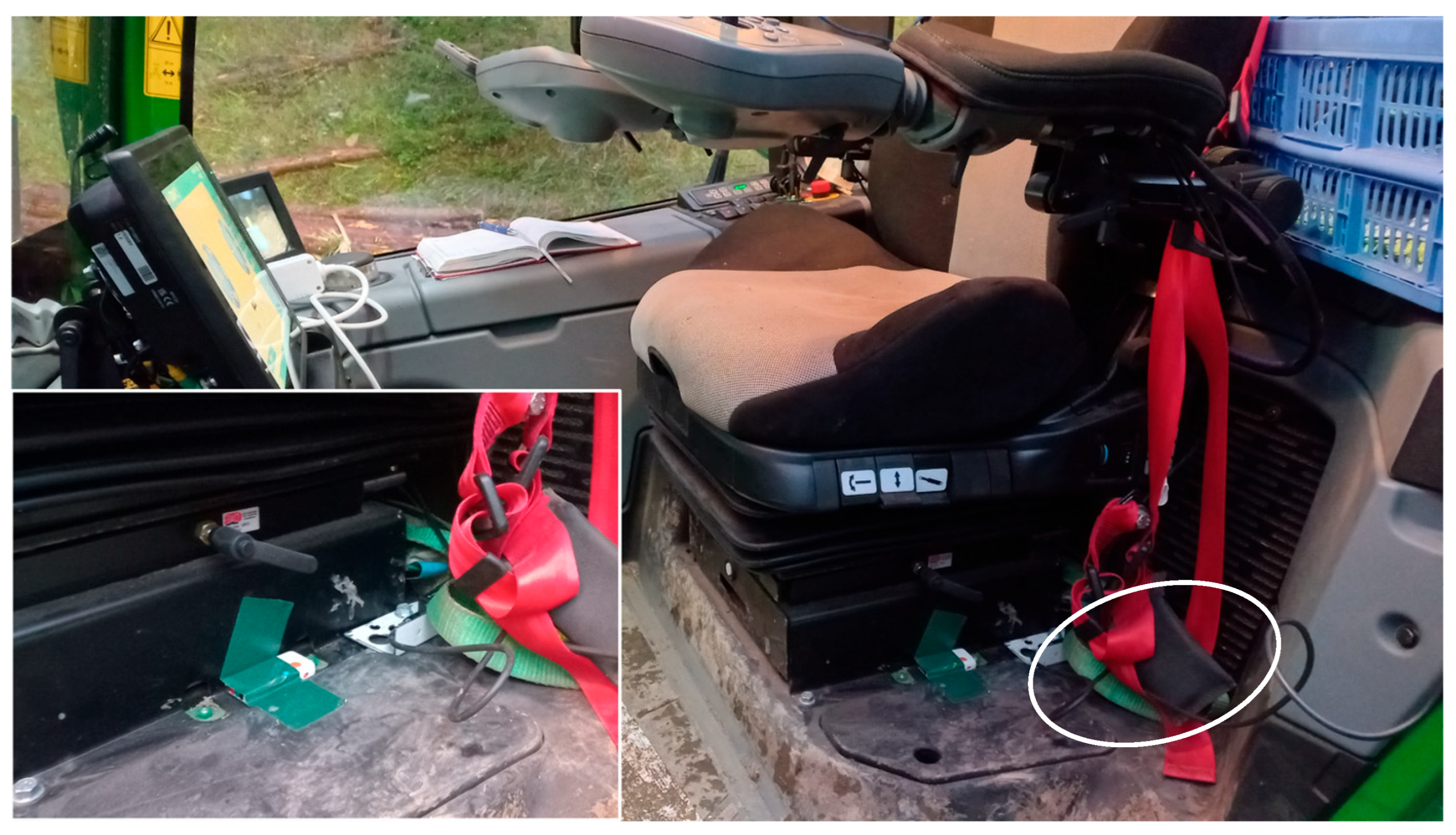
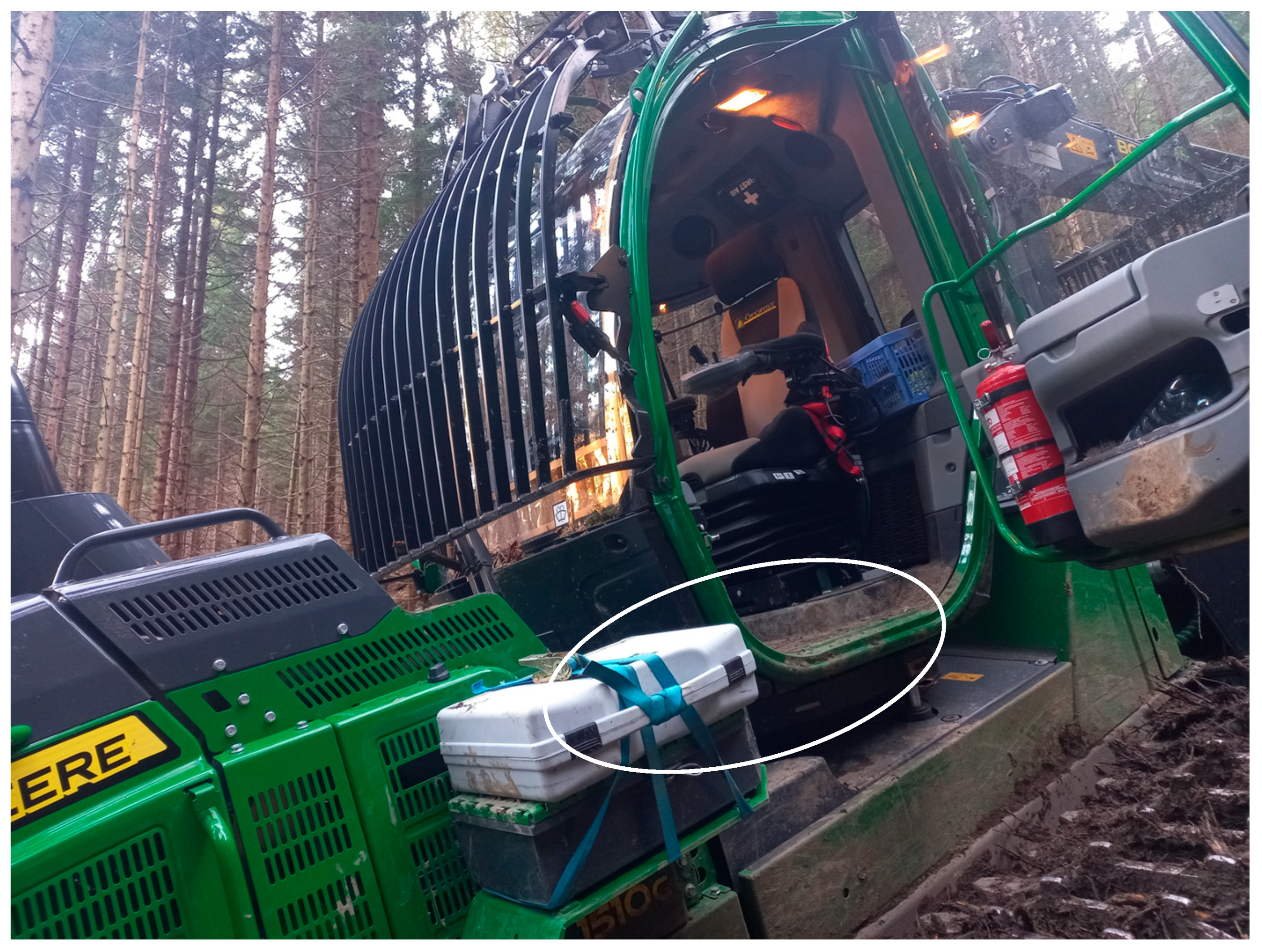

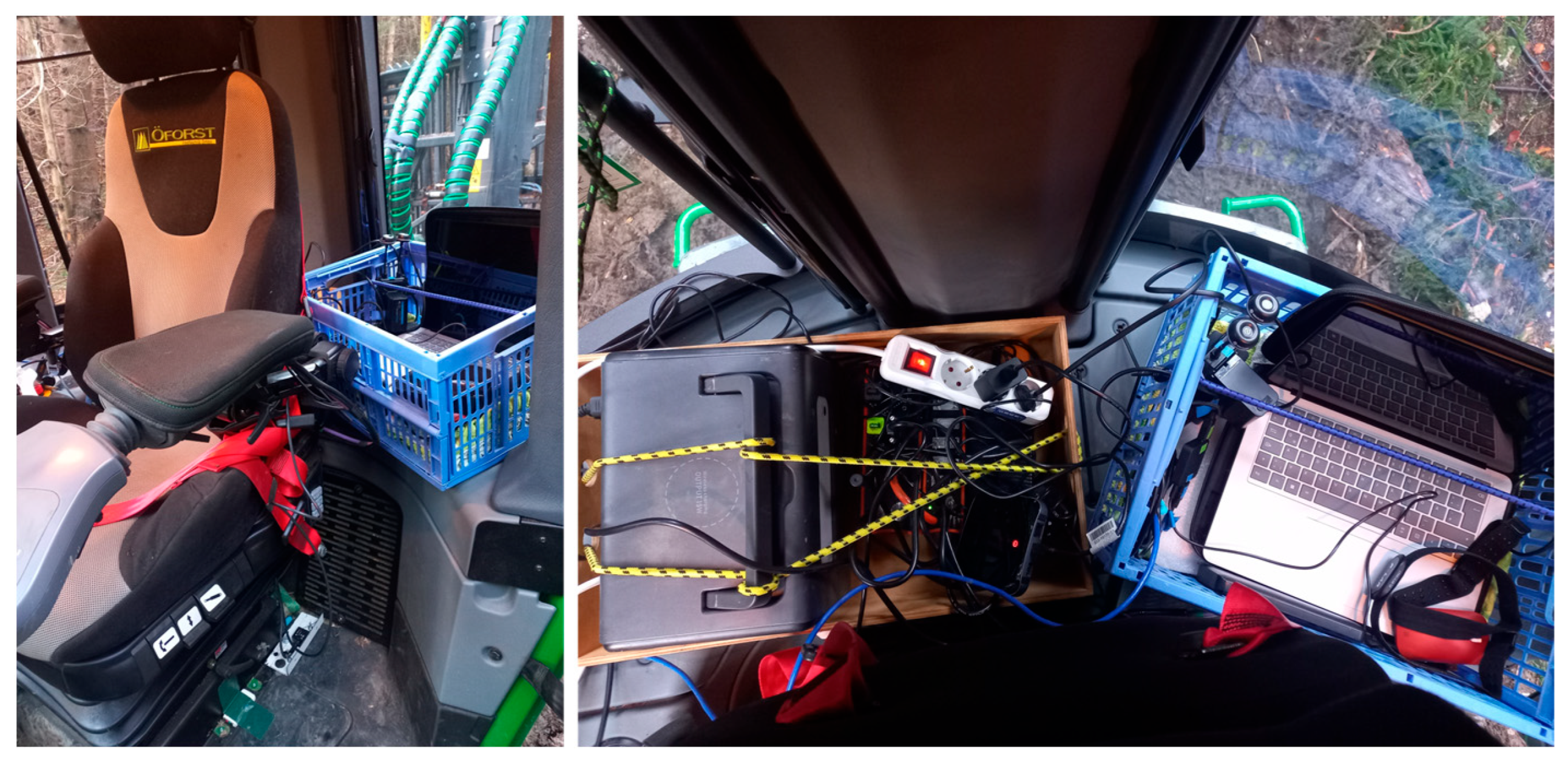
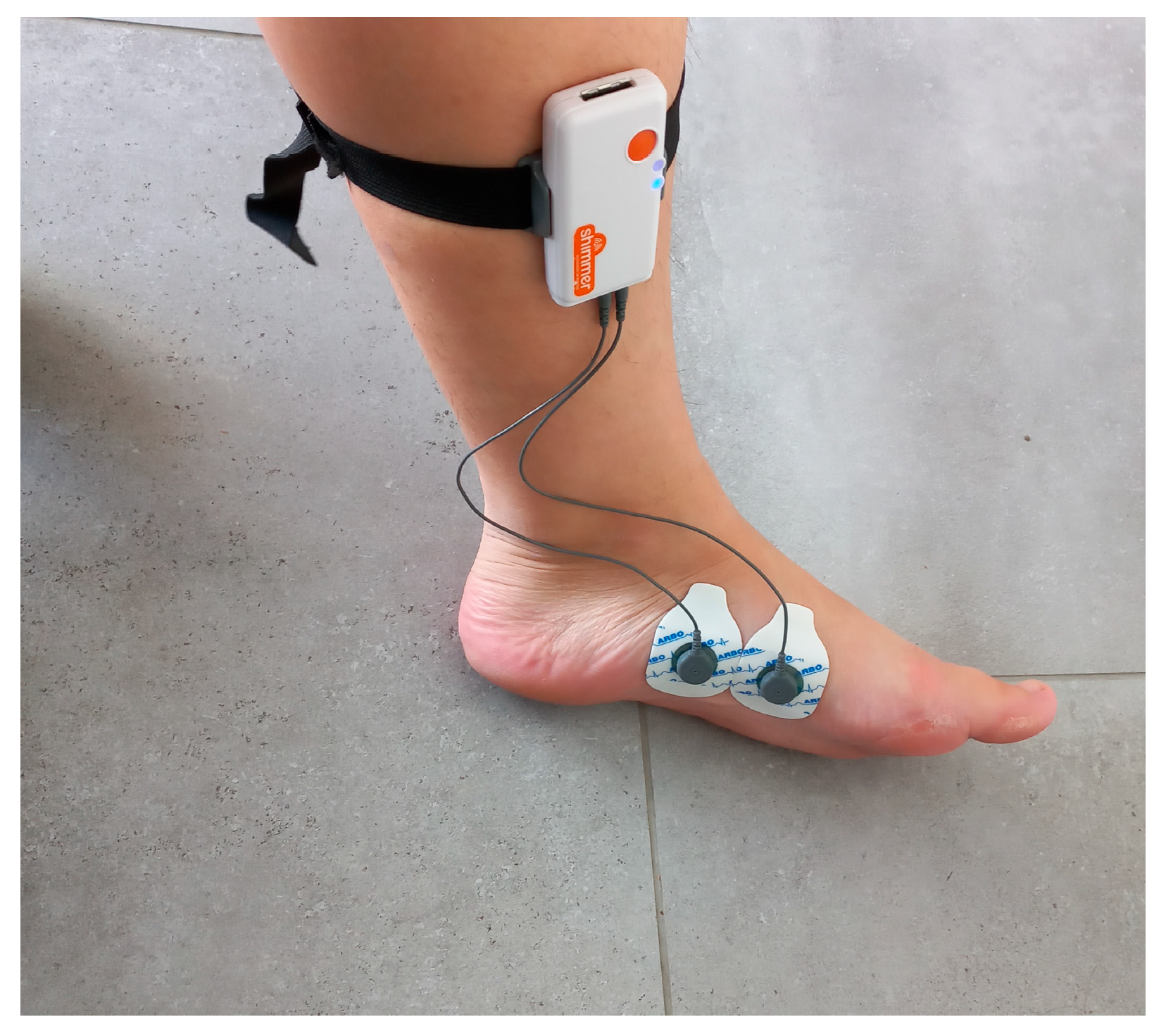
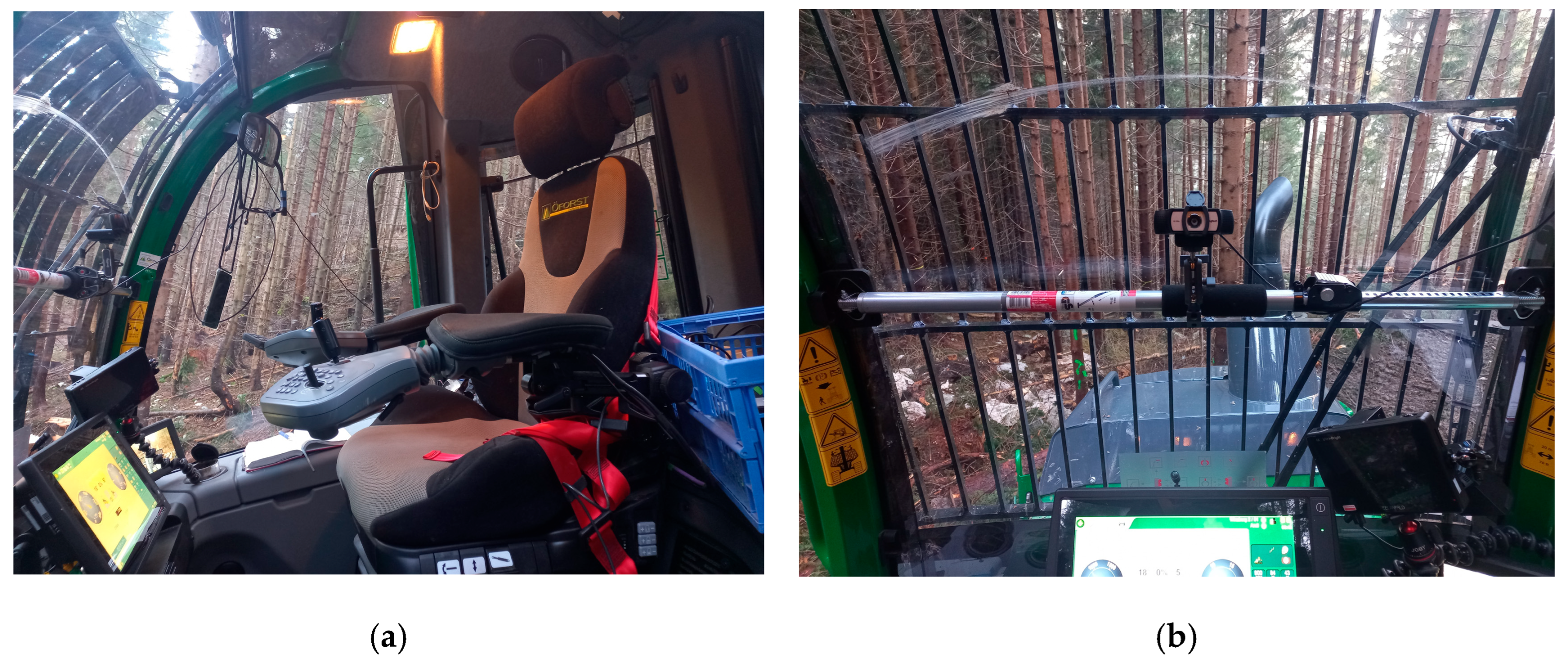
| Task | Forwarder | Harvester |
|---|---|---|
| A | Driving forwards | Boom movement |
| B | Driving backwards | Felling a tree |
| C | Loading logs | Processing |
| D | Manipulation of logs on platform | Manipulation of branches |
| E | Manipulation of logs, limbs, and stumps | Log manipulation |
| F | Unload logs | Manipulation of logs |
| G | Handling the winch | Driving forwards |
| H | - | Driving backwards |
| Category | Parameter | T1 | T2 | T3 | Device/Tool |
|---|---|---|---|---|---|
| Forest environment | Acceleration | x | x | x | Shimmer3 EXG Unit |
| Slope gradient 1 | x | x | x | Althen NSS1-IP | |
| Inclination of cabin 2 | x | x | x | Dewesoft DS-Gyro1 | |
| Machine-related | Tasks performed | x | x | x | GoPro |
| Psychological | Questionnaires | x | SQS | ||
| x | FS-A | ||||
| responses | x | FAS | |||
| x | BMS II-A | ||||
| x | FS-B | ||||
| x | BMS II-B | ||||
| x | SF-12 | ||||
| x | OrgFit | ||||
| x | RESTQ-Work | ||||
| Interview | x | Roland R-07 | |||
| Psychophysiological | HRV | x | x | Polar H10 | |
| Eye fixation duration | x | x | Pupil Invisible | ||
| responses | Cortisol level | x | Hair sample | ||
| EDA | x | x | Shimmer3 GSR+ unit | ||
| Facial expressions 3 | x | x | AFFDEX | ||
| Technical outcomes | Productivity | x | x | x | GoPro |
| Stand damage | x | Measuring tape |
| Parameter | Reference (SD)/Threshold Value |
|---|---|
| BMS II-A [55]: | |
| Mental fatigue | 38 |
| Monotony | 39 |
| Mental satiation | 38 |
| Stress | 38 |
| BMS II-B [55]: | |
| Mental fatigue | 40 |
| Monotony | 41 |
| Mental satiation | 40 |
| Stress | 45 |
| SF-12 [58]: | |
| PCS | 49.6 (8.7) |
| MCS | 52.3 (8.0) |
| OrgFit [60]: | |
| Work tasks and activities | 2.66 (0.93) |
| Social and organizational climate | 2.4 (1.01) |
| Working environment | 1.54 (1.02) |
| Work processes and work organization | 2.05 (0.98) |
| RESTQ-Work [59]: | |
| Recovery | 3.4 (1.01) |
| Stress | 1.85 (1.3) |
| HRV [67]: | |
| 16–19 years | 70.1 ms |
| 20–29 years | 51.9 ms |
| 30–39 years | 37.7 ms |
| 40–49 years | 29.9 ms |
| 50–59 years | 24.1 ms |
| 60–69 years | 20.7 ms |
| Fixation duration [27] | >150 ms |
| Hair cortisol level [68] | 182–520 pg/mg 1 |
Disclaimer/Publisher’s Note: The statements, opinions and data contained in all publications are solely those of the individual author(s) and contributor(s) and not of MDPI and/or the editor(s). MDPI and/or the editor(s) disclaim responsibility for any injury to people or property resulting from any ideas, methods, instructions or products referred to in the content. |
© 2025 by the authors. Licensee MDPI, Basel, Switzerland. This article is an open access article distributed under the terms and conditions of the Creative Commons Attribution (CC BY) license (https://creativecommons.org/licenses/by/4.0/).
Share and Cite
Foisner, V.; Haas, C.; Göttlicher, K.; Hartl, A.; Huber, C. The Psychophysiological Interrelationship Between Working Conditions and Stress of Harvester and Forwarder Drivers—A Study Protocol. Forests 2025, 16, 1693. https://doi.org/10.3390/f16111693
Foisner V, Haas C, Göttlicher K, Hartl A, Huber C. The Psychophysiological Interrelationship Between Working Conditions and Stress of Harvester and Forwarder Drivers—A Study Protocol. Forests. 2025; 16(11):1693. https://doi.org/10.3390/f16111693
Chicago/Turabian StyleFoisner, Vera, Christoph Haas, Katharina Göttlicher, Arnulf Hartl, and Christoph Huber. 2025. "The Psychophysiological Interrelationship Between Working Conditions and Stress of Harvester and Forwarder Drivers—A Study Protocol" Forests 16, no. 11: 1693. https://doi.org/10.3390/f16111693
APA StyleFoisner, V., Haas, C., Göttlicher, K., Hartl, A., & Huber, C. (2025). The Psychophysiological Interrelationship Between Working Conditions and Stress of Harvester and Forwarder Drivers—A Study Protocol. Forests, 16(11), 1693. https://doi.org/10.3390/f16111693







